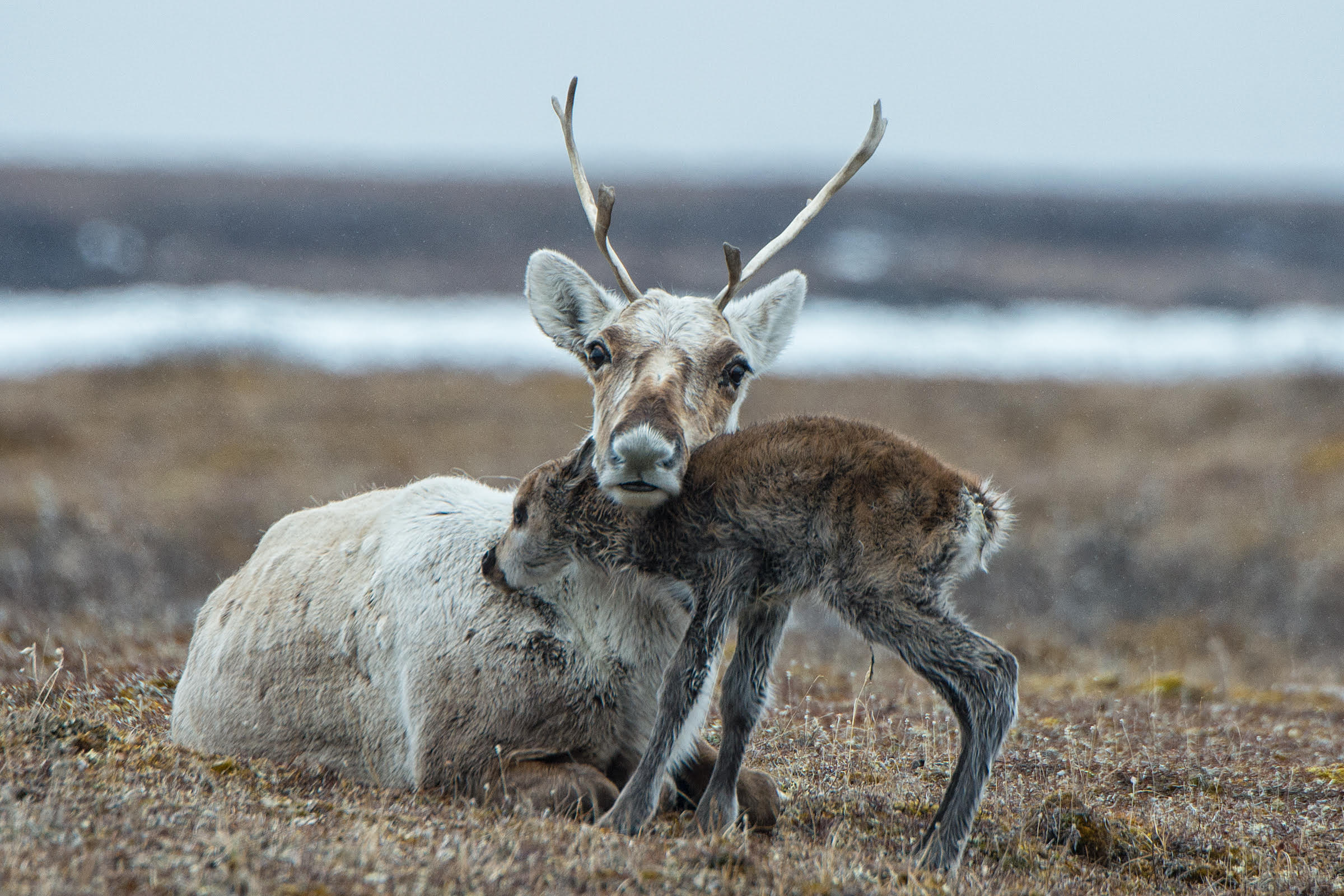
THE JOURNEY
Every year, the Porcupine caribou herd embarks on the longest land migration on earth, traversing over four thousand kilometres of the Northwest Territories, Yukon, and Alaska. Caribou give birth to their calves on the coastal plain of the Arctic National Wildlife Refuge, which provides nourishment, relief from predators, and respite from noxious insects. The Arctic Refuge is called Iizhik Gwats’an Gwandaii Goodlit by the Gwich’in, The Sacred Place Where Life Begins. For countless generations caribou have sustained the Gwich’in communities across the north.
At last count the Porcupine caribou herd numbered 218,000. It is one of the healthiest barren-ground caribou herds left in the world, thanks to both a long history of thoughtful co-management and efforts by the Gwich’in and environmental groups to protect their calving grounds.
THE THREAT
Oil and gas development has long threatened the Arctic Refuge. For decades, the Gwich’in have travelled across North America to advocate for the protection of the herd’s calving grounds, and have helped build enormous public support for protecting the Refuge.
These efforts kept drilling at bay for decades, but that changed in December of 2017. The U.S. Congress approved the Tax Cuts and Jobs Act, and with it an unrelated provision which opened the Arctic Refuge to oil and gas leasing.
In the spring of 2018 the U.S. Department of Interior began a rushed environmental review. Throughout the review the Gwich’in, environmental groups and the public expressed huge opposition to drilling, and pointed out repeated flaws in the review. The U.S. Government held two public comment periods, and both times over 500 Yukoners voiced support for the Porcupine caribou herd.
In August of 2020, the Interior Department released its Record of Decision, bringing its environmental review to a close. To nobody’s surprise, Interior gave the go ahead to the most aggressive scenario imaginable: one that would offer up the entire coastal plain to oil companies, and place the fewest restrictions on drilling.
In January of 2021, the Trump administration held a lease sale for the Arctic Refuge. The sale brought in less than one percent of the revenues drilling proponents promised and many tracts were not bid on. Then on President Biden’s first day in office in June 2021, he signed an executive order to suspend the oil and gas leasing program in the Arctic Refuge. While this was great news, the suspension did not mean protection.
WHAT WE’RE DOING
Shortly after the Record of Decision was released, CPAWS Yukon and twelve other groups filed a lawsuit against the Department of Interior. The lawsuit is led by the Gwich’in Steering Committee, and will be argued by lawyers from Trustees for Alaska, a public interest environmental law group.
We contend that the Department of Interior broke the law in many ways, such as by not adequately considering alternatives, failing to take a hard look at the consequences of drilling and not adequately addressing the threats to Gwich’in subsistence rights. If we prevail, we hope the courts will invalidate the Department of Interior’s environmental review, and any decisions that stem from it.
There’s a parallel campaign to protect the Arctic Refuge, one that focuses on banks and oil companies. Developing oil fields in the Arctic Refuge would be staggeringly expensive, and potential drillers may depend on outside financing to make these projects happen. CPAWS Yukon, the Vuntut Gwitchin and Gwich’in Tribal Council are campaigning for Canadian banks to rule out funding for Arctic Refuge drilling. Thanks to efforts from the Gwich’in Tribal Council and the Sierra Club, five major banks in the U.S. and more than a dozen overseas have pledged not to finance drilling in the Arctic. These policies are limiting the pool of finance available to oil companies, and giving the fossil fuel industry one more reason to be wary of drilling in the Arctic Refuge.
WHAT’S NEXT?
Unfortunately, the law that originally opened the Arctic Refuge to oil leasing is still on the books, including the possibility of another lease sale. The political realities of the U.S. Congress has meant that President Biden has not been able to sign a law to restore protections to the Arctic Refuge, and that means there is more work to be done to defend the Arctic Refuge and the Porcupine caribou herd.
The good news is that the last few years have shown once again how much support there is for the Gwich’in and the Porcupine caribou herd. Efforts to safeguard the Arctic Refuge have won unlikely allies in the dozens of banks that have pledged never to fund drilling in the Arctic, and even oil companies are showing their reluctance to pursue drilling in the Arctic Refuge. We’re staying watchful, and will let you know whenever we need your help to protect the Porcupine caribou herd.












